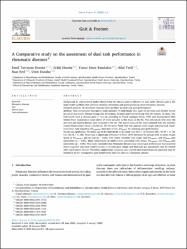A Comparative study on the assessment of dual task performance in rheumatic diseases

View/
Access
info:eu-repo/semantics/embargoedAccessDate
10.01.2022Author
Taşvuran Horata, EmelHorata, Erdal
Kundakçı, Yunus Emre
Yeşil, Hilal
Erel, Suat
Dündar, Ümit
Metadata
Show full item recordCitation
Horata, E. T., Horata, E., Kundakcı, Y. E., Yesil, H., Erel, S., & Dundar, U. (2022). A Comparative Study on the Assessment of Dual Task Performance in Rheumatic Diseases. Gait & Posture.Abstract
Background
In task-oriented studies showed that the chronic pain is effective on dual tasks. Chronic pain is the main health problem that prevents mobility restriction and participation in most rheumatic diseases.
Research question
Do rheumatic diseases have an effect on dual task gait performance?
Methods
This comparative-descriptive study included 75 individuals who aged 18–65 years and divided in two groups as Rheumatic Disease Group (RG; 23 women, 14 men) and Control Group (CG; 20 women, 18 men). The individuals have a chronic pain (> 3.4 cm according to Visual Analogue Scale, VAS) and Standardized Mini Mental State Examination score above 24 were included in this study as the RG. The individuals who were did not have any known disease were included in the CG. The health status of RG was evaluated with the Arthritis Impact Measurement Scale 2 (AIMS-2). The 10-meter Walk Test was applied under single and dual task conditions (dual task cognitive, DTcognitive; dual task motor, DTmotor) for assessing gait performance.
Results and significance
The mean age of the individuals in the study was 40.6 ± 11.34 years (RG=43.08 ± 11.30; CG=38.18 ± 11.00). There was a significant difference in favor of CG between the groups both in terms of gait speed in DTcognitive and its cost (p < 0.05). VAS scores correlate with single and DTcognitive and DTmotor gait parameters (p < 0.05). Many subdivisions of AIMS-2 were associated with single, DTcognitive and DTmotor gait parameters (p < 0.05). This study concluded that rheumatic diseases may reduce gait performance in concurrent motor-cognitive dual task conditions due to chronic pain. Single and dual task gait parameters may be related with psychosocial factors. Therefore, applications including pain control and biopsychosocial approach may be beneficial in the management gait disturbances and falls due to a rheumatic disease.















